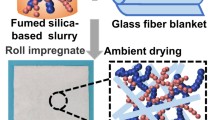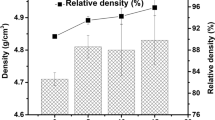Abstract
Phosphorous-containing silica was prepared by acid hydrolysis of sodium silicate via a cost-effective sol–gel method. Phosphorus was incorporated during synthesis of silica by adding three different phosphorus compounds namely di-sodium hydrogen orthophosphate, orthophosphoric acid, and hypophosphorous acid. The silica powder was analyzed by Fourier transform infrared spectroscopy (FTIR), thermogravimetric analysis (TGA), scanning electron microscopy (SEM), and dynamic light scattering (DLS). FTIR spectrum shows the presence of phosphorous in the samples. SEM picture of phosphorous containing silica is globular whereas pure silica is fluffier. The EDX results indicate the phosphorous incorporation up to 5 wt% atomic weight. TGA analysis shows approximately 15 wt% loss up to 150 °C for oven dried samples and the residue at 700 °C is higher for phosphorous containing samples. DLS results show the particle size for all the samples near 1000 nm. Limiting oxygen index (LOI) and smoke density of the epoxy composite samples was evaluated. The LOI value of the phosphorous containing silica composite material has been slightly improved. But the burning behavior of the samples indicates the sufficient formation of protective char layer and the char analysis of the composite samples shows more bubble structure. This type of foam structure of the char protects the surface from fire propagation.
Graphical abstract













Similar content being viewed by others
References
Chen X, Gu A, Liang G, Yuan L, Zhuo D, Hu JT (2012) Novel low phosphorus-content bismaleimide resin system with outstanding flame retardancy and low dielectric loss. Polym Degrad Stab 97(5):698–706
Klinkowski C, Wagner S, Ciesielski M, Doring M (2014) Bridged phosphorylated diamines: synthesis, thermal stability and flame retarding properties in epoxy resins. Polym Degrad Stab 106:122–128
Wang T, Wan PY, Qin PY, Yu M (2008) Synthesis and characterization of dicyclopentadiene–cresol epoxy resin. Poly Bull 59(6):787–793
Gao LP, Wang DY, Wang YZ, Wang JS, Yang B (2008) A flame-retardant epoxy resin based on a reactive phosphorus-containing monomer of DODPP and its thermal and flame-retardant properties. Polym Degrad Stab 93(7):1308–1315
El Gouri M, El Bachiri A, Hegazi SE, Rafik M, El Harfi A (2009) Thermal degradation of a reactive flame retardant based on cyclotriphosphazene and its blend with DGEBA epoxy resin. Polym Degrad Stab 94(11):2101–2106
Gu L, Chen G, Yao Y (2014) Two novel phosphorus–nitrogen-containing halogen-free flame retardants of high performance for epoxy resin. Polym Degrad Stab 108:68–75
Sen AK, Kumar S (2010) Coir-fiber-based fire retardant nano filler for epoxy composites. J Therm Anal Calorim 101(1):265–271
Liang S, Neisius NM, Gaan S (2013) Recent developments in flame retardant polymeric coatings. Prog Org Coat 76(11):1642–1665
Balabanovich AI, Hornung A, Merz D, Seifert H (2004) The effect of a curing agent on the thermal degradation of fire retardant brominated epoxy resins. Polym Degrad Stab 85(1):713–723
Covaci A, Voorspoels S, Abdallah MA, Geens T, Harrad S, Law RJ (2009) Analytical and environmental aspects of the flame retardant tetrabromobisphenol-A and its derivatives. J Chromatogr A 1216(3):346–363
Buczko A, Stelzig T, Bommer L, Rentsch D, Heneczkowski M, Gaan S (2014) Bridged DOPO derivatives as flame retardants for PA6. Polym Degrad Stab 107:158–165
Lu SY, Hamerton I (2002) Recent developments in the chemistry of halogen-free flame retardant polymers. Prog Polym Sci 27(8):1661–1712
Schartel B (2010) Phosphorus-based flame retardancy mechanisms—old hat or a starting point for future development? Mater J 3(10):4710–4745
Jeng RJ, Shau SM, Lin JJ, Su WC, Chiu YS (2002) Flame retardant epoxy polymers based on all phosphorus-containing components. Eur Polym J 38(4):683–693
Dong Q, Liu M, Ding Y, Wang F, Gao C, Liu P, Wen B, Zhang S, Yang M (2013) Synergistic effect of DOPO immobilized silica nanoparticles in the intumescent flame retarded polypropylene composites. Polym Adv Technol 24(8):732–739
Chen Y, Zhan J, Zhang P, Nie S, Lu H, Song L, Hu Y (2010) Preparation of intumescent flame retardant poly (butylene succinate) using fumed silica as synergistic agent. Ind Eng Chem Res 49(17):8200–8208
Alongi J, Colleoni C, Rosace G, Malucelli G (2012) Thermal and fire stability of cotton fabrics coated with hybrid phosphorus-doped silica films. J Therm Anal Calorim 110(3):1207–1216
Shewale PM, Rao AV, Rao AP, Bhagat SD (2009) Synthesis of transparent silica aerogels with low density and better hydrophobicity by controlled sol–gel route and subsequent atmospheric pressure drying. J Sol–Gel Sci Technol 49(3):285–292
Lin YS, Lin HP, Mou CY (2004) A simple synthesis of well-ordered super-microporous aluminosilicate. Microporous Mesoporous Mater 76(1):203–208
Meenakshi KS, Sudhan EP, Kumar SA (2012) Development and characterization of new phosphorus based flame retardant tetraglycidyl epoxy nanocomposites for aerospace application. Bull Mater Sci 35(2):129–136
Giraldo L, Bastidas-Barranco M, Moreno-Pirajan JC (2016) Adsorption calorimetry: energetic characterisation of the surface of mesoporous silicas and their adsorption capacity of non-linear chain alcohols. Colloids Surf A 496:100–113
Dong Q, Ding Y, Wen B, Wang F, Dong H, Zhang S, Wang T, Yang M (2014) Improvement of thermal stability of polypropylene using DOPO-immobilized silica nanoparticles. Colloid Polym Sci 290(14):1371–1380
Music S, Filipovic-Vincekovic N, Sekovanic L (2011) Precipitation of amorphous SiO2 particles and their properties. Braz J Chem Eng 28(1):89–94
Bryans TR, Brawner VL, Quitevis EL (2000) Microstructure and porosity of silica xerogel monoliths prepared by the fast sol–gel method. J Sol–Gel Sci Technol 17(3):211–217
Kalapathy U, Proctor A, Shultz J (2000) A simple method for production of pure silica from rice hull ash. Biores Technol 73(3):257–262
Olhero SM, Ferreira JM (2004) Influence of particle size distribution on rheology and particle packing of silica-based suspensions. Powder Technol 139(1):69–75
Jesionowski T, Krysztafkiewicz A (2002) Preparation of the hydrophilic/hydrophobic silica particles. Colloids Surf A 207(1):49–58
Massiot P, Centeno MA, Gouriou M, Dominguez MI, Odriozola JA (2003) Sol–gel obtained silicophosphates as materials to retain caesium at high temperatures. J Mater Chem A 13(1):67–74
Massiot P, Centeno MA, Carrizosa I, Odriozola JA (2001) Thermal evolution of sol–gel-obtained phosphosilicate solids (SiPO). Non-Cryst Solids 292(1):158–166
Wang X, Hu Y, Song L, Xing W, Lu H, Lv P, Jie G (2010) Flame retardancy and thermal degradation mechanism of epoxy resin composites based on a DOPO substituted organophosphorus oligomer. Polym 51(11):2435–2445
Liu YL, Wei WL, Hsu KY, Ho WH (2004) Thermal stability of epoxy-silica hybrid materials by thermogravimetric analysis. Thermochim Acta 412(1):139–147
Liu YL, Hsu CY, Wei WL, Jeng RJ (2003) Preparation and thermal properties of epoxy-silica nanocomposites from nanoscale colloidal silica. Polymer 44(18):5159–5167
Ho TH, Hwang HJ, Shieh JY, Chung MC (2009) Thermal, physical and flame-retardant properties of phosphorus-containing epoxy cured with cyanate ester. React Funct Polym 69(3):176–182
Cavdar AD (2014) Effect of various wood preservatives on limiting oxygen index levels of fire wood. Measurement 50:279–284
Suzanne M, Delichatsios MA, Zhang JP (2014) Flame extinction properties of solids obtained from limiting oxygen index tests. Combust Flame 161(1):288–294
Qian X, Song L, Hu Y, Jiang S (2016) Novel DOPO-based epoxy curing agents. J Therm Anal Calorim 126(3):1339–1348
Qian X, Song L, Hu Y, Yuen RK (2013) Thermal degradation and flammability of novel organic/inorganic epoxy hybrids containing organophosphorus-modified oligosiloxane. Thermochim Acta 552:87–97
Alongi J, Collconi C, Rosace G, Malucelli G (2012) Thermal and fire stability of cotton fabrics coated with hybrid phosphorus-doped silica films. J Therm Anal Calorim 110:1207–1216
Chiang C, Ma C (2002) Synthesis, characterization and thermal properties of novel epoxy containing silicon and phosphorous nanocomposites by sol–gel method. Eur Polym J 38:2219–2224
Wang X, Hu Y, Song L, Yang H, Xing W, Lu H (2011) Synthesis and characterization of a DOPO-substitued organophosphorus oligomer and its application in flame retardant epoxy resins. Prog Org Coat 71(1):72–82
Sponton M, Ronda JC, Galia M, CAdiz V (2009) Cone calorimetry studies of benzoxazine–epoxy systems flame retarded by chemically bonded phosphorus or silicon. Polym Degrad Stab 94(1):102–106
Acknowledgements
The authors are gratefully acknowledge the financial support from NRB DRDO sponsored project (NRB/4003/PG/340). The authors are also acknowledge the characterization facility (Central Instrumentation Facility) at Birla Institute of Technology Mesra.
Author information
Authors and Affiliations
Corresponding author
Ethics declarations
Conflict of interest
The authors declare that they have no competing interests.
Rights and permissions
About this article
Cite this article
Shree, V., Sen, A.K. Study of thermal and flame behavior of phosphorus-based silica for epoxy composites. J Sol-Gel Sci Technol 85, 269–279 (2018). https://doi.org/10.1007/s10971-017-4546-1
Received:
Accepted:
Published:
Issue Date:
DOI: https://doi.org/10.1007/s10971-017-4546-1




